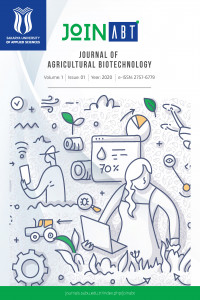Öz
Kaynakça
- Chen, H. L. (2018). Isolation AndIdentification Of The Anti-Oxidant Constituents From Loropetalum chinense (R. Brown)Oliv. Based On UHPLC–Q-TOF-MS/MS. Molecules, 23(1720), 2-15.
- Gawel, N. J. (1996). Identification Of Genetic Diversity Among Loropetalum chinense var. rubrumIntroductions. J. Environ. Hort., 14(1), 38-41.
- Bao, Z. C. (2007). Variation In Morphological Traits Among Loropetalum chinense var. rubrumAccessions. HORTSCIENCE, 42(2), 399-402.
- Zhang, Q. F. (2013). Isolation Of New Flavan-3-Ol And LignanGlucoside From Loropetalum chinenseAnd Their Antimicrobial Activities. Fitoterapia, 90, 228-232. doi:10.1016/j.fitote.2013.08.003
- Gong, W. L. (2016). From Glacial Refugia To Wide Distribution Range: Demographic Expansion Of Loropetalum chinense (Hamamelidaceae)In Chinese Subtropical Evergreen Broadleaved Forest. Org Divers Evol, 16, 23-38.
- Zhou, X. X. (2011). A New Lignan From The Leaves Of Loropetalum chinensis. Chemistry Of Natural Compounds, 47(5), 690-692.
- Demirbaş, A. R. (2010). Süs Bitkileri Yetiştiriciliği. Samsun: Samsun Tarım İl Müdürlüğü Çiftçi Eğitimi ve Yayım Şubesi.
- Aygün, G. (2015). Bitki Büyüme Düzenleyicilerinin Anthurium andreanum L.Türünün İki Çeşidinin Mikroçoğaltımı Üzerindeki Etkileri. Yüksek Lisans Tezi. Çanakkale OnsekizMart Üniversitesi Fen Bilimleri Enstitüsü.
- Babaoğlu, M. G. (2001). Bitki Biyoteknolojisi 1 Doku Kültürü ve Uygulamaları. Selçuk Üniversitesi Vakfı Yayınları.
- Hamidi Birecikli, A. (2018). Balcı Aspir (Carthamus tinctorius L.) Çeşidinin Mikroçoğaltımı. Yüksek Lisans Tezi. Batman Üniversitesi Fen Bilimleri Enstitüsü.
- Düzer, E. (2010). Origanum OnitesVe Origanum MajoranaBitkileri İle Meristem Kültürü Kullanılarak Stres Fizyolojisi Çalışması. Anadolu Üniversitesi Fen Bilimleri Enstitüsü.
- Bajpai, V. K. (2019).Antioxidant And Antimicrobial Efficacy Of A Biflavonoid, Amentoflavone From Nandina Domestica In VitroAnd In Minced Chicken Meat And Apple Juice Food Models. Food Chemistry, 239-247.
- Tang, Q. Z. (2005). Factors Effecting Pollen Germination Percentage OfL.chinensis var rubrumAnd L.chinensis. Hunan Forestry Science And Technology, 4.
- Wang, H. T. (2006). Studies On Callus Inducing Of Loropetalum chinense var.rubrum.Journal Of Yueyang Vocational Technical College, 6. Yin, H. T. (2008). A Preliminary Study On The Tissue Culture To Overcome The Vitrification Of Loropetalum chinense Oliver var rubrumYieh. Journal Of Jiangsu Forestry Science & Technology, 3. Li, Y. Y. (2011). Induction And Cultivation Of Haploid Callus Of Loropetalum chinense var. rubrum. Journal Of Hunan Agricultural University, 37(6), 632-636
Öz
The ornamental plant sector has been increasing rapidly in the world and in Turkey in recent years. It is aimed to develop micropropagation protocols of Loropetalum chinense(Chinese fringe flower), whichare increasingly used in our country and are difficult to produce with traditional methods.For this purpose, from the MS and DKW mediawhich are used commonly; MS-Mod and DKW-Mod mediaprepared considering the soil requirements of the plants were used for this plant. In Loropetalum chinensemediaexperiments, the best number of shoots per explant (1.76 shoots/explant) was produced on DKW with 1 mg L-1of BAP. Also It was determined that the MS-Mod mediawith 1.00 mg L-1BAP (1.63 shoots/explant) is suitable for Loropetalum chinensemicropropagation. According to the results obtained in the study, the nutrient media that can be used for micropropagation were determined for the plant Loropetalum chinense(Chinesefringe flower).
Anahtar Kelimeler
Chinese fringe flower Clonal propagation Loropetalum chinense Micropropagation Plant media Tissue culture
Kaynakça
- Chen, H. L. (2018). Isolation AndIdentification Of The Anti-Oxidant Constituents From Loropetalum chinense (R. Brown)Oliv. Based On UHPLC–Q-TOF-MS/MS. Molecules, 23(1720), 2-15.
- Gawel, N. J. (1996). Identification Of Genetic Diversity Among Loropetalum chinense var. rubrumIntroductions. J. Environ. Hort., 14(1), 38-41.
- Bao, Z. C. (2007). Variation In Morphological Traits Among Loropetalum chinense var. rubrumAccessions. HORTSCIENCE, 42(2), 399-402.
- Zhang, Q. F. (2013). Isolation Of New Flavan-3-Ol And LignanGlucoside From Loropetalum chinenseAnd Their Antimicrobial Activities. Fitoterapia, 90, 228-232. doi:10.1016/j.fitote.2013.08.003
- Gong, W. L. (2016). From Glacial Refugia To Wide Distribution Range: Demographic Expansion Of Loropetalum chinense (Hamamelidaceae)In Chinese Subtropical Evergreen Broadleaved Forest. Org Divers Evol, 16, 23-38.
- Zhou, X. X. (2011). A New Lignan From The Leaves Of Loropetalum chinensis. Chemistry Of Natural Compounds, 47(5), 690-692.
- Demirbaş, A. R. (2010). Süs Bitkileri Yetiştiriciliği. Samsun: Samsun Tarım İl Müdürlüğü Çiftçi Eğitimi ve Yayım Şubesi.
- Aygün, G. (2015). Bitki Büyüme Düzenleyicilerinin Anthurium andreanum L.Türünün İki Çeşidinin Mikroçoğaltımı Üzerindeki Etkileri. Yüksek Lisans Tezi. Çanakkale OnsekizMart Üniversitesi Fen Bilimleri Enstitüsü.
- Babaoğlu, M. G. (2001). Bitki Biyoteknolojisi 1 Doku Kültürü ve Uygulamaları. Selçuk Üniversitesi Vakfı Yayınları.
- Hamidi Birecikli, A. (2018). Balcı Aspir (Carthamus tinctorius L.) Çeşidinin Mikroçoğaltımı. Yüksek Lisans Tezi. Batman Üniversitesi Fen Bilimleri Enstitüsü.
- Düzer, E. (2010). Origanum OnitesVe Origanum MajoranaBitkileri İle Meristem Kültürü Kullanılarak Stres Fizyolojisi Çalışması. Anadolu Üniversitesi Fen Bilimleri Enstitüsü.
- Bajpai, V. K. (2019).Antioxidant And Antimicrobial Efficacy Of A Biflavonoid, Amentoflavone From Nandina Domestica In VitroAnd In Minced Chicken Meat And Apple Juice Food Models. Food Chemistry, 239-247.
- Tang, Q. Z. (2005). Factors Effecting Pollen Germination Percentage OfL.chinensis var rubrumAnd L.chinensis. Hunan Forestry Science And Technology, 4.
- Wang, H. T. (2006). Studies On Callus Inducing Of Loropetalum chinense var.rubrum.Journal Of Yueyang Vocational Technical College, 6. Yin, H. T. (2008). A Preliminary Study On The Tissue Culture To Overcome The Vitrification Of Loropetalum chinense Oliver var rubrumYieh. Journal Of Jiangsu Forestry Science & Technology, 3. Li, Y. Y. (2011). Induction And Cultivation Of Haploid Callus Of Loropetalum chinense var. rubrum. Journal Of Hunan Agricultural University, 37(6), 632-636
Ayrıntılar
| Birincil Dil | İngilizce |
|---|---|
| Konular | Ziraat, Veterinerlik ve Gıda Bilimleri |
| Bölüm | Araştırma Makaleleri |
| Yazarlar | |
| Yayımlanma Tarihi | 31 Aralık 2020 |
| Gönderilme Tarihi | 4 Aralık 2020 |
| Yayımlandığı Sayı | Yıl 2020 Cilt: 1 Sayı: 1 |


